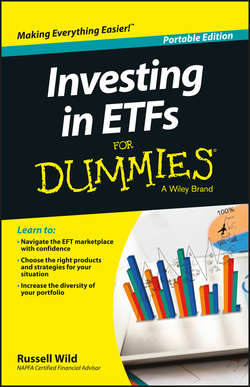Читать книгу Investing in ETFs For Dummies - Russell Wild - Страница 9
Part I
Getting Started with ETFs
Chapter 1
The (Sort of Still) New Kid on the Block
Passive versus Active Investing: Your Choice
ОглавлениеSurely, you’ve sensed by now my preference for index funds over actively managed funds. Until recently, all ETFs were index funds. And in the past few years, most index funds have been ETFs.
On March 25, 2008, Bear Stearns introduced an actively managed ETF: the Current Yield ETF (YYY). As fate would have it, Bear Stearns was just about to go under, and when it did, the first actively managed ETF went with it. Prophetic? Perhaps. In the years since, about 130 actively managed ETFs, from 29 providers, have hit the street, with quite modest commercial success. But time will tell… .
I don’t think this development is necessarily a bad thing, but I’m not frothing at the mouth to invest in actively managed ETFs, either.
In the next few sections, I look at a few of the pros and cons.
The index advantage
The superior returns of indexed mutual funds and ETFs over actively managed funds have had much to do with the popularity of ETFs to date. Index funds (which buy and hold a fixed collection of stocks or bonds) consistently outperform actively managed funds. One study done by Fulcrum Financial tracked mutual fund performance over ten years and found that 81 percent of value funds underperformed the indexes, as did 63 percent of growth funds. And that is just one of many, many studies that present similar results.
Here are some reasons that index funds (both mutual funds and ETFs) are hard to beat:
✔ They typically carry much lower management fees, sales loads, or redemption charges.
✔ Hidden costs – trading costs and spread costs – are much lower when turnover is low.
✔ They don’t have cash sitting around idle (as the manager waits for what he thinks is the right time to enter the market).
✔ They are more – sometimes much more – tax efficient.
✔ They are more “transparent” – you know exactly what securities you are investing in.
Perhaps the greatest testament to the success of index funds is how many allegedly actively managed funds are actually index funds in (a very expensive) disguise. I’m talking about closet index funds. According to a report in Investment News, a newspaper for financial advisers, the number of actively managed stock funds that are closet index funds has tripled over the past several years. As a result, many investors are paying high (active) management fees for investment results that could be achieved with low-cost ETFs.
R squared is a measurement of how much of a fund’s performance can be attributed to the performance of an index. It can range from 0.00 to 1.00. An R squared of 1.00 indicates perfect correlation: When a fund goes up, it’s because the index was up – every time; when the fund falls, it’s because the index fell – every time. An R squared of 0.00 indicates no such correlation. This measurement is used to assess tracking errors and to identify closet index funds.
According to Morningstar data as interpreted by Investment News, nearly 28 percent of all large cap funds carry a three-year R squared of 0.95 or higher relative to the S&P 500 stock index. That kind of number makes them closet index funds. And if you look at the entire mutual fund industry, it is apparent that the triumph of indexing is becoming well known. Recently, the average large cap fund had an R squared of almost 0.90. That number is up from 0.74 only a decade or so ago.
The allure of active management
Speaking in broad generalities, actively managed mutual funds have been no friend to the small investor. Their dominance remains a testament to people’s ignorance of the facts and the enormous amount of money spent on (often deceptive) advertising and PR that give investors the false impression that buying this fund or that fund will lead to instant wealth. The media often plays into this nonsense with splashy headlines, designed to sell magazine copies or attract viewers, that promise to reveal which funds or managers are currently the best.
Конец ознакомительного фрагмента. Купить книгу
